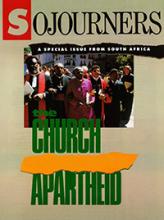"THE LORD ANSWER YOU in the day of trouble! The name of God protect you!...Some boast of chariots, and some of horses; but we boast of the name of the Lord our God. They will collapse and fall; but we shall rise and stand upright."
Allan Boesak Jr., age 9, read slowly from Psalm 20 at the conclusion of the family dinner. The words that appeared in the lectionary reading that night were particularly poignant. Just the day before, Allan's father had publicly announced to a packed cathedral that the Botha regime had signed its own death warrant.
Three nights before that, a large brick came flying through the Boesaks' living room window, sending shattered glass in all directions; a death threat over the phone followed. Allan Jr. and his 12-year-old sister, Pulane, had decided to sleep on the floor of the large walk-in closet in their parents' bedroom for a few nights, while a group of theology students kept watch through the night outside the house.
But conversation at the dinner table that evening was anything but somber. In spite of the threats that surrounded it, the Boesak home was full of joy and life. There was fear, to be sure, but laughter was a more frequent expression.
What I remember most about that evening, our second in South Africa, was not the spicy curry or the swelling background music of "Mozart's Hornpipe Concerto," but the faces around the table—the delight on Pulane's, mirrored in her father's; the compassion in Dorothy's; and the warmth from Leineke and Belen. But especially the intent look on Allan Jr.'s face as he read from the psalm the promises of God to us all in a difficult time.
Read the Full Article
